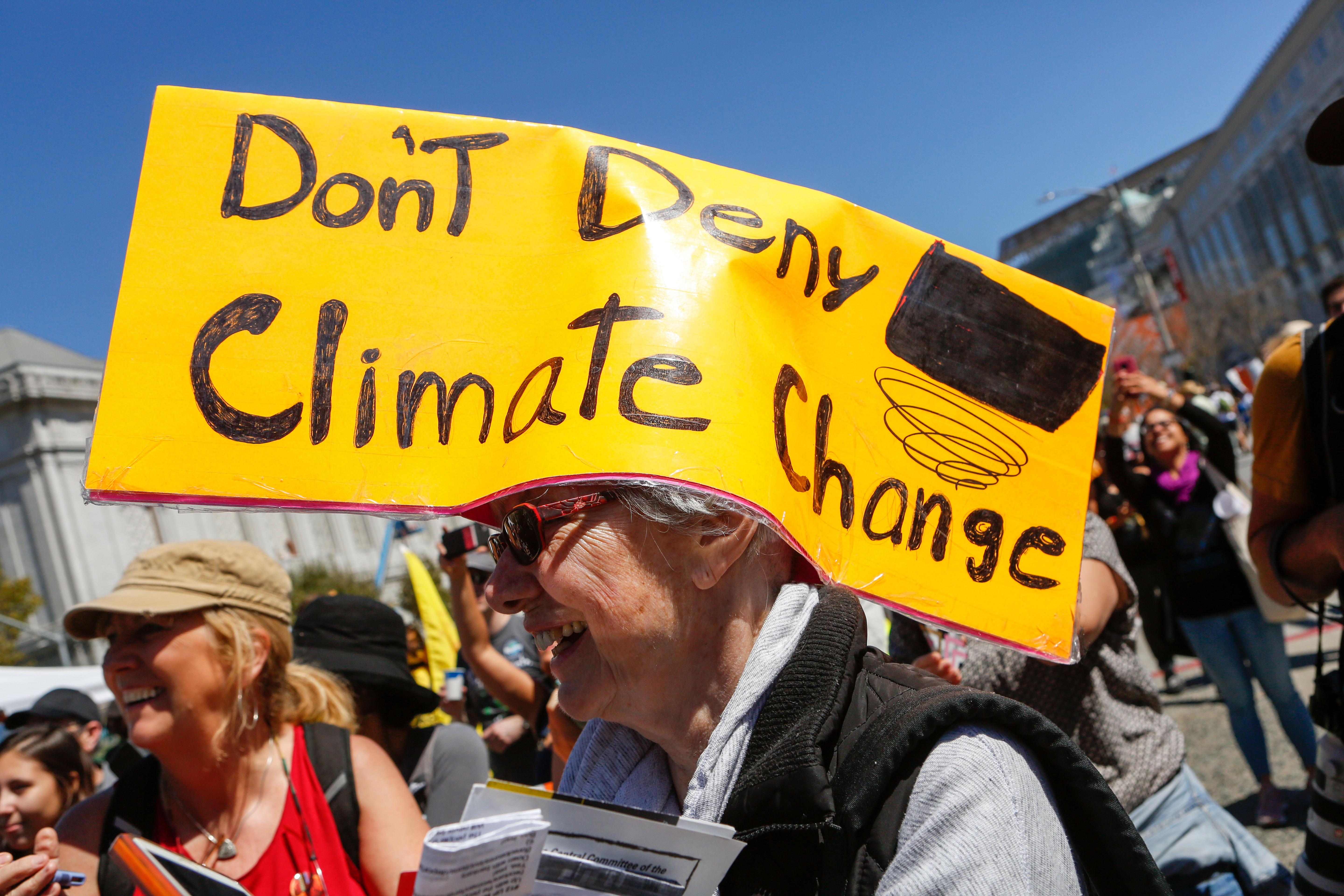World faces uphill climate fight as US efforts fall short
Protesters marched in the “Rise For Climate” global action on September 8, 2018 in San Francisco (Amy Osborne)
San Francisco (AFP) – The United States will fall short on its Paris commitment to cut greenhouse gases, making the uphill battle to avoid runaway global warming that much harder, according to a report released hours ahead of a major, solutions-oriented climate summit in San Francisco.
As thousands of governors, mayors, CEOs and experts gathered for the Global Climate Action Summit, they were warned that a crescendo of efforts at the subnational level to shrink the US carbon footprint cannot overcome President Donald Trump’s decision to scrap his predecessor’s climate policies and promote the use of fossil fuels.
“The Obama target was always going to be a stretch,” co-author Paul Bodnar, managing director of the Rocky Mountain Institute, told journalists.
“This work shows definitively that states, cities and businesses have the power to bring the nation to the brink of that ambitious target through their own authorities.”
The three-day conference will see dozens of cities, provinces, states and multinational companies pledge to run on clean energy — mostly solar or wind — within a few decades.
Leading the way, outgoing California governor Jerry Brown signed legislation this week committing the state to purging greenhouse gases from its electricity grid by 2045.
“We all have the opportunity and the obligation to do our part to combat climate change,” he told AFP after signing the bill into law.
– A monster hurricane –
Megacities will likely announce greenhouse gas emissions trending downward, and governors will unveil partnerships supporting indigenous efforts to sustainably manage tropical, carbon-dense forests.
Nearly 1,000 institutional investors overseeing trillions in assets have, at least in part, turned their backs on planet-warming fossil fuels.
“This summit is going to be a showcase for the whole world in terms of climate action,” said Ethan Elkind, head of the climate program at the Center for Law, Energy & the Environment at the University of California, Berkeley.
But “glass-half-full” optics cannot obscure the fact that global warming continues to outpace efforts to tame it, in the US and across the globe.
A monster hurricane threatening to unleash “catastrophic” flooding and storm surges on the US East Coast — bearing the telltale fingerprint of climate change — underscores that reality.
After remaining stable for three years, raising hopes that they had peaked, carbon dioxide emissions from human sources rose in 2017 to historic levels.
“If we do not change course by 2020, we risk missing the point where we can avoid runaway climate change,” UN Secretary-General Antonio Guterres said earlier this week, warning of a “dark and dangerous future.”
The 196-nation Paris Agreement calls for capping global warming at “well below” two degrees Celsius (3.6 degrees Fahrenheit), and vows to strive for a 1.5 C limit if possible.
But even if all nations honor voluntary carbon-cutting vows submitted in an annex, we are trending toward a world at least 3 C warmer than the preindustrial era, a scenario scientists say would tug at the fabric of civilization.
– ‘We Are Still In’ –
With only a single degree Celsius of warming so far, our planet is already coping with deadly droughts, erratic rainfall, and storm surges engorged by rising seas — all made worse by climate change, according to scientists.
Trump opted out of the Paris Agreement shortly after gaining office, and has hammered away at the domestic and international climate policies of his predecessor, Barack Obama.
Financed by former New York mayor Michael Bloomberg, the “Fulfilling America’s Pledge” report kicks off the three-day, solutions-oriented summit in the heart of Democratic America.
“Current federal and real economy commitments, combined with market forces, will drive US emissions to 17 percent below 2005 levels by 2025 — roughly two-thirds of the way to the original US target,” the report found.
Under the Paris deal, the United States committed to cutting its carbon pollution 26-28 percent by 2025.
The 2015 treaty marked the first time that all countries — including emerging giants such as China and India — laid out specific targets for greening their economies.
Trump wants to relax pollution rules for coal-fired power plants and roll back car-mileage standards, the twin pillars of Obama’s Clean Energy Plan.
He has also challenged California’s right to set its own vehicle fuel standards.
The transport sector is the single largest source of man-made greenhouse gases in the United States.
US mayors, governors and business leaders — under the banner “We Are Still In” — have pushed back by adopting more ambitious targets at the local level.
Taken together, these jurisdictions represent about half of the US economy, the equivalent of the third-largest country in the world, according to the report.
Disclaimer: This story has not been edited by Siliconeer and is published from a syndicated feed. Siliconeer does not assume any liability for the above story. Validity of the above story is for 7 Days from original date of publishing. Content copyright AFP.


